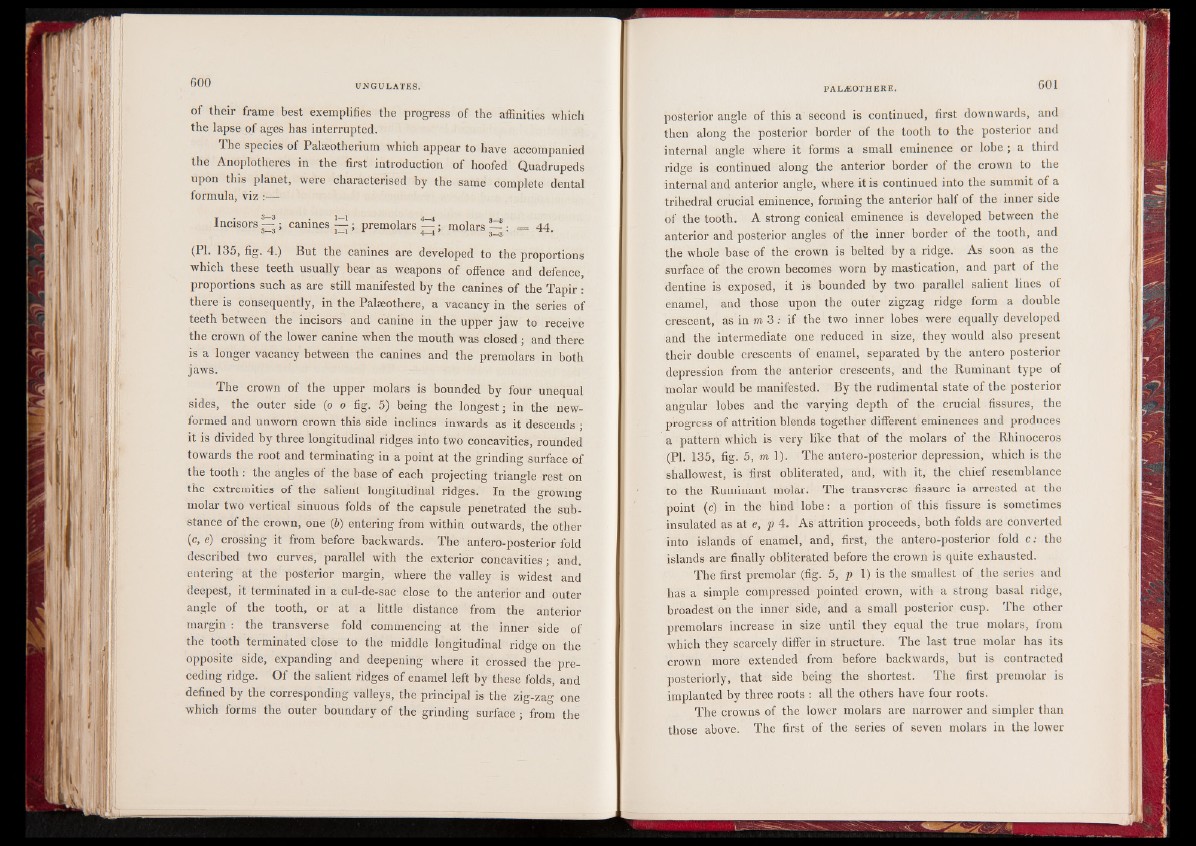
of their frame best exemplifies the progress of the affinities which
the lapse of ages has interrupted.
The species of Palaeotherium which appear to have accompanied
the Anoplotheres in the first introduction of hoofed Quadrupeds
upon this planet, were characterised by the same complete dental
formula, viz
Incisors—?; canines^?; premolars— ; molars—V = 44
(PI. 135, fig. 4.) But the canines are developed to the proportions
which these teeth usually bear as weapons of offence and defence,
proportions such as are still manifested by the canines of the Tapir :
there is consequently, in the Palaeothere, a vacancy in the series of
teeth between the incisors and canine in the upper jaw to receive
the crown of the lower canine when the mouth was closed ; and there
is a longer vacancy between the canines and the premolars in both
jaws.
The crown of the upper molars is bounded by four unequal
sides, the outer side (o o fig. 5) being the longest; in the new-
formed and unworn crown this side inclines inwards as it descends ;
it is divided by three longitudinal ridges into two concavities, rounded
towards the root and terminating in a point at the grinding surface of
the tooth : the angles of the base of each projecting triangle rest on
the extremities of the salient longitudinal ridges. In the growing
molar two vertical sinuous folds of the capsule penetrated the substance
of the crown, one (6) entering from within outwards, the other
(c, e) crossing it from before backwards. The antero-posterior fold
described two curves, parallel with the exterior concavities ; and,
entering at the posterior margin, where the valley is widest and
deepest, it terminated in a cul-de-sac close to the anterior and outer
angle of the tooth, or at a little distance from the anterior
margin : the transverse fold commencing at the inner side of
the tooth terminated close to the middle longitudinal ridge on the
opposite side, expanding and deepening where it crossed the preceding
ridge. Of the salient ridges of enamel left by these folds, and
defined by the corresponding valleys, the principal is the zig-zag one
which forms the outer boundary of the grinding surface ; from the
posterior angle of this a second is continued, first downwards, and
then along the posterior border of the tooth to the posterior and
internal angle where it forms a small eminence or lobe ; a third
ridge is continued along the anterior border of the crown to the
internal and anterior angle, where it is continued into the summit of a
trihedral crucial eminence, forming the anterior half of the inner side
of the tooth. A strong conical eminence is developed between the
anterior and posterior angles of the inner border of the tooth, and
the whole base of the crown is belted by a ridge. As soon as the
surface of the crown becomes worn by mastication, and part of the
dentine is exposed, it is bounded by two parallel salient lines of
enamel, and those upon the outer zigzag ridge form a double
crescent, as in m 3: if the two inner lobes were equally developed
and the intermediate one reduced in size, they would also present
their double crescents of enamel, separated by the antero posterior
depression from the anterior crescents, and the Ruminant type of
molar would he manifested. By the rudimental state of the posterior
angular lobes and the varying depth of the crucial fissures, the
progress of attrition blends together different eminences and produces
a pattern which is very like that of the molars of the Rhinoceros
(PL 135, fig. 5, m 1). The antero-posterior depression, which is the
shallowest, is first obliterated, and, with it, the chief resemblance
to the Ruminant molar. The transverse fissure is arrested at the
point (c) in the hind lobe: a portion of this fissure is sometimes
insulated as at e, p 4. As attrition proceeds, both folds are converted
into islands of enamel, and, first, the antero-posterior fold c: the
islands are finally obliterated before the crown is quite exhausted.
The first premolar (fig. 5, p 1) is the smallest of the series and
has a simple compressed pointed crown, with a strong basal ridge,
broadest on the inner side, and a small posterior cusp. The other
premolars increase in size until they equal the true molars, from
which they scarcely differ in structure. The last true molar has its
crown more extended from before backwards, but is contracted
posteriorly, that side being the shortest. The first premolar is
implanted by three roots : all the others have four roots.
The crowns of the lower molars are narrower and simpler than
those above. The first of the series of seven molars in the lower